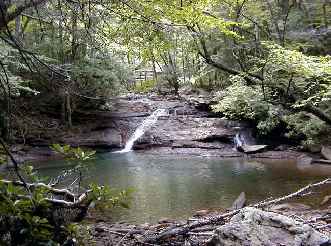HILLSBORO
 home to the Pearl S. Buck museum.
home to the Pearl S. Buck museum. This house was built by the Stulting family who emigrated from Holland to America in 1847. They lived on this sixteen acre farm which became the birthplace of Pearl Comfort Sydenstricker on June 26, 1892.
This house was built by the Stulting family who emigrated from Holland to America in 1847. They lived on this sixteen acre farm which became the birthplace of Pearl Comfort Sydenstricker on June 26, 1892. Pearl, who was born to an ill-matched pair of Southern Presbyterian missionaries, was taken to China at the age of three months and lived there for forty years.
Pearl, who was born to an ill-matched pair of Southern Presbyterian missionaries, was taken to China at the age of three months and lived there for forty years.
Later, writing under her married name of Pearl S. Buck, she won the hearts of Americans with her famous novel, THE GOOD EARTH, for which she won the PULITZER PRIZE FOR LITERATURE in 1932. For the high quality of her literary work, she was awarded the NOBEL PRIZE FOR LITERATURE in 1938.
 Pearl Buck was the first American woman to ever receive both of these awards. On June 24, 1983, the Pearl Buck U.S. Postal Stamp was issued at Hillsboro as a tribute to this great lady. To see more famous people, go toFamous People
Not only do we get to see the birthplace of Pearl, but of her father also.
Pearl Buck was the first American woman to ever receive both of these awards. On June 24, 1983, the Pearl Buck U.S. Postal Stamp was issued at Hillsboro as a tribute to this great lady. To see more famous people, go toFamous People
Not only do we get to see the birthplace of Pearl, but of her father also. The Sydenstricker House, birthplace of Pearl Buck's father, originally in Greenbrier County, has been dismantled, transported 40 miles, and reconstructed here for use as a cultural center, with the log section as a Sydenstricker Museum. Thus the Birthplace has grown into a farm complex, adding a new historical dimension!
The Sydenstricker House, birthplace of Pearl Buck's father, originally in Greenbrier County, has been dismantled, transported 40 miles, and reconstructed here for use as a cultural center, with the log section as a Sydenstricker Museum. Thus the Birthplace has grown into a farm complex, adding a new historical dimension!

CASS

Well here we are men. I think this stop is for you. We've come to the CASS SCENIC RAILROAD STATE PARK.

The Cass Railroad was built in 1901 and used to haul lumber to the mill in Cass. Invented to do the impossible, the Shay logging locomotive was designed to climb the steepest grades, swing around hairpin curves and negotiate frail, temporary tracks. To haul the incredibly heavy loads from woods to mill, power was all-important. This State Park's concept is to preserve a Logging
Railroad from the early part of the last century.
At Cass you will see Logging Locomotives. These Locomotives are geared steam locomotives. The folks at Cass have restored them to excellent condition.
This State Park's concept is to preserve a Logging
Railroad from the early part of the last century.
At Cass you will see Logging Locomotives. These Locomotives are geared steam locomotives. The folks at Cass have restored them to excellent condition. In 1911, West Virginia led the nation with over 3,000 miles of logging railroad line. It's all gone now with the exception of the 11 miles used for tourists....which we are!!! Instead of timber, these hugh locomotives now haul passengers in the old logging flatcars and they've been redone in cherry and green. Whee, aint they purty. Come on, let's go for a ride.

WHOO, WHOO, Green Bank next stop.

GREEN BANK

and the NATIONAL RADIO ASTRONOMY OBSERVATORY. Whew! That's a mouth full. Do you find yourself wondering about the mysteries of the universe? YOU ARE NOT ALONE..... Sitting in the middle of the Monongahela National Forest, scientists at the observatory are searching for answers to some very fundamental questions: How big is space? When were the galaxies created? Who or what else is out there?
Sitting in the middle of the Monongahela National Forest, scientists at the observatory are searching for answers to some very fundamental questions: How big is space? When were the galaxies created? Who or what else is out there?Scientists from all over the world come here to study black holes, galaxies, exploding stars,etc. Why do you suppose that is? Well, there are seven telescopes currently in operation, including the world's largest equatorially mounted telescope, which rotates in all directions.
 The observatory occupies 2,600 acres in Deer Creek Valley protected by surrounding mountains from unwanted man-made radio interference. This is the world's only region where public and private radio transmissions are restricted.
The observatory occupies 2,600 acres in Deer Creek Valley protected by surrounding mountains from unwanted man-made radio interference. This is the world's only region where public and private radio transmissions are restricted. Transmissions are restricted? Shhhhh, let's tiptoe out of here and move on to our next stop.

HUTTONSVILLE
 Hey guys, we've come to the KUMBRABOW STATE FOREST, which is West Virginia's highest state forest. Look at these pretty pictures I found.
Hey guys, we've come to the KUMBRABOW STATE FOREST, which is West Virginia's highest state forest. Look at these pretty pictures I found.
 How would everyone like to spend the night here and rough it? No electricity, we could read by gaslight (I guess that means a lantern). We ladies will have to cook over a wood stove and you guys will have to haul water from a well... (did you see a well?), or I guess that pond. There's supposed to be some rustic cabins around here somewhere, but I didn't see any pictures of them. Maybe that trail up there will lead us to where they might be. Hummmmm, I think we better just get in our old Chevy and hit the road.
How would everyone like to spend the night here and rough it? No electricity, we could read by gaslight (I guess that means a lantern). We ladies will have to cook over a wood stove and you guys will have to haul water from a well... (did you see a well?), or I guess that pond. There's supposed to be some rustic cabins around here somewhere, but I didn't see any pictures of them. Maybe that trail up there will lead us to where they might be. Hummmmm, I think we better just get in our old Chevy and hit the road.Everyone get your cameras ready because we are heading for...

SENECA ROCKS

which is one of the most photographed landmarks in West Virginia. It's an unforgetable sight...huge Tuscarora sandstone rocks lunging straight out of the earth to a height of 900 feet. These towering giants were formed at the end of the Paleozoic geologic era, when the ancestral continents of Africa and North America collided, bending and buckling rock layers deep within the earth's crust.
These towering giants were formed at the end of the Paleozoic geologic era, when the ancestral continents of Africa and North America collided, bending and buckling rock layers deep within the earth's crust.During the 1940's, U.S. Army troops were trained here in preparation for climbing European mountains. Seneca Rocks is still considered by some to be the most challenging climb in the east. Would you believe they have mountain climbing schools here?
I hope you all got some good pictures, cause I'm ready to move on. Our next stop will be ...

DAVIS/THOMAS

While we've been driving thru all these different places, have you noticed the beauty of the land? Look at how the highways have been cut through the mountains. WHAT'S THAT? IT KINDA SOUNDS LIKE RUSHING WATER. And that's exactly what it is. Get your cameras ready again because we're coming to BLACKWATER FALLS. It's true, you will hear it before you see it. These falls plunge from a height of five stories. This natural wonder tumbles along through a wooded eight mile gorge lined with rhododendron and hemlock. In fact, it is the acids from decaying hemlocks and red spruce needles that give the water its "blackness". Blackwater Falls is actually a part of BLACKWATER FALLS STATE PARK. This is ski country, and the park's second biggest attraction is snow. Blackwater is full of beautiful trails, many of which become excellent cross-country ski routes in the winter. And we're just going to ski right into....oh, alright, I guess we can drive to
This natural wonder tumbles along through a wooded eight mile gorge lined with rhododendron and hemlock. In fact, it is the acids from decaying hemlocks and red spruce needles that give the water its "blackness". Blackwater Falls is actually a part of BLACKWATER FALLS STATE PARK. This is ski country, and the park's second biggest attraction is snow. Blackwater is full of beautiful trails, many of which become excellent cross-country ski routes in the winter. And we're just going to ski right into....oh, alright, I guess we can drive to

ROMNEY

Romney seems to have a little feud going with Shepherdstown as to who is the oldest. Romney claims that honor, but they both were incorporated in 1762. During the Civil War, Romney changed hands 56 times...three times in one day!  Thomas "Stonewall" Jackson headquarted here for a while during the war, and reportedly became so angry when ordered to abandon Romney, that he threatened to resign his commission. After the Civil War on Sept. 26, 1867, local citizens dedicated what was perhaps the first Confederate Memorial in the United States. It still stands today in Indian Mound Cemetery in Romney.
Thomas "Stonewall" Jackson headquarted here for a while during the war, and reportedly became so angry when ordered to abandon Romney, that he threatened to resign his commission. After the Civil War on Sept. 26, 1867, local citizens dedicated what was perhaps the first Confederate Memorial in the United States. It still stands today in Indian Mound Cemetery in Romney.
 The School for the Deaf and Blind is right here in Romney.
The School for the Deaf and Blind is right here in Romney. 
We have family that works here, and some family members also attended this school.The next thing is....well, I'll just say if you like "old", you'll like this.  One of the oldest houses in Romney, now a Museum of Civil War artifacts, is owned by Hampshire County Public Library. The original log home, built in 1798, stands on its original lot, 155 West Main St. beside Hampshire County Public Library. The Davis family was "divided" during the Civil war. The museum is open during the summer.
One of the oldest houses in Romney, now a Museum of Civil War artifacts, is owned by Hampshire County Public Library. The original log home, built in 1798, stands on its original lot, 155 West Main St. beside Hampshire County Public Library. The Davis family was "divided" during the Civil war. The museum is open during the summer.
As we're leaving the Potomac region, there's one more stop I'd like to make, and that's in....

FORT ASHBY

 This large, hand-hewn log structure in Fort Ashby looks peaceful enough now, but it's origin recalls a time of violent change.
This large, hand-hewn log structure in Fort Ashby looks peaceful enough now, but it's origin recalls a time of violent change.In the 18th century, this area was considered the extreme edge of the frontier and was vulnerable to Indian attack at any time. In 1755, when Col. George Washington directed that a chain of 69 forts be built to protect the settlers, Fort Ashby was among the first to be constructed. Today, it is the only one still standing. Now a museum, the building encloses a massive chimney 14 feet wide, and four feet thick; the large doors on the side of the building were designed to accomodate horses dragging in huge logs to be rolled into the fireplace.
Next we'll be going to the Eastern Panhandle.
